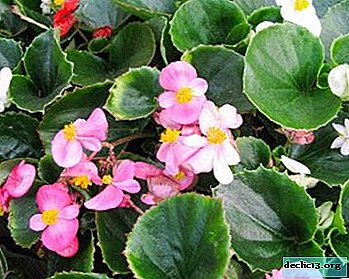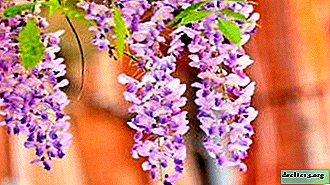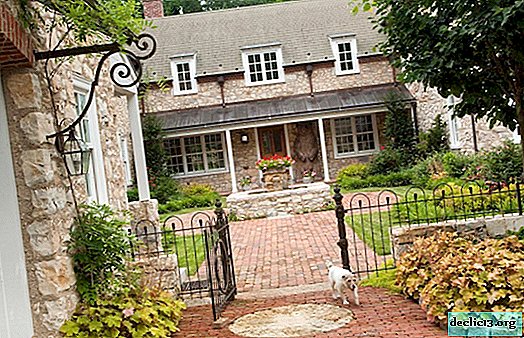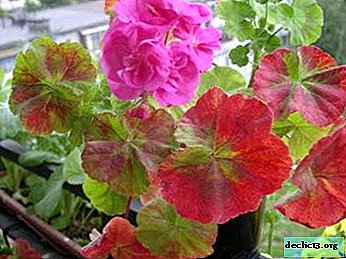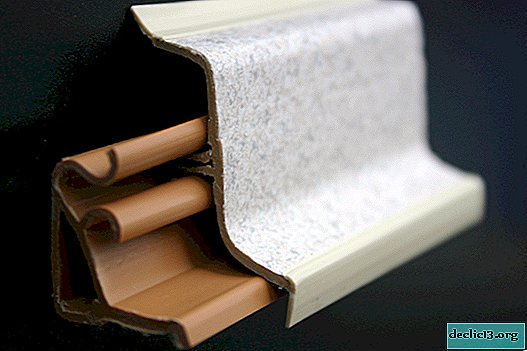Gasteria: home care. Planting, reproduction, pests and diseases, photo
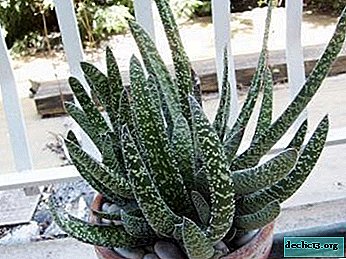
Gasteria is a succulent plant of the subfamily Asphodelaceae of the Xanthorrhoeae family. Cultivated as decorative foliage and flowering.
Thick leaves of Gasteria are green or variegated and form a two-row rosette, similar to a fan. In some types of Gasteria, the outlet becomes spirally twisted with age. The height of the gastery is from 4-5 cm to 1 m, depending on the type and variety.
In this article we will talk about the features of caring for this plant, show visual photos, as well as acquaintance with the characteristic pests and diseases of this plant.
How to care for a plant?
Location
Gasterias respond well to fresh air, so in summer they can be placed on the balcony or loggia, and in winter - in a regularly ventilated room. Note that the plant does not tolerate drafts. For the time of airing, clean the gastery from the window.
Lighting
Like most succulents, Gasteria relate well to the direct sun. South and southwest windows are the best choice for them, but in the conditions of bright diffused light Gasteria will grow. On the north side, the plant will need additional lighting, especially in winter.
For artificial lighting, you can use fluorescent lamps with a cold white glow or special full-spectrum diodes with a minimum of 60 lamps per meter.
Temperature
 During the period of active growth, the optimum temperature for the content of gasteria is 25 degrees, but the plant will withstand higher summer temperatures. Wintering is preferably cool, about 10-12 ° C. Under such conditions, flower buds begin to lay in the gasteria, and by the spring orange-red inflorescences appear. If it is not possible to create such conditions, slide the plant to the window on the windowsill as much as possible.
During the period of active growth, the optimum temperature for the content of gasteria is 25 degrees, but the plant will withstand higher summer temperatures. Wintering is preferably cool, about 10-12 ° C. Under such conditions, flower buds begin to lay in the gasteria, and by the spring orange-red inflorescences appear. If it is not possible to create such conditions, slide the plant to the window on the windowsill as much as possible.
Gasteria leaves should not touch window glassotherwise, over time, frostbite of the tissues will occur. The affected leaf will become a threat to the life of the plant, bacteria and fungi can easily settle in it.
Air humidity
Adult Gasteria humidity is undemanding and are satisfied with the dry air of apartments. Moreover, spraying can harm the gasteria.
Reference! If water stagnates regularly in the axils of thick leaves, this will cause them to rot.Also, drops of water on the leaves under the direct sun turn into small lenses, which can cause burns to the leaf plate. High humidity is needed only for seeds to germinate and seedlings of Gasteria at first.
Watering
The homeland of Gasteria is South Africa, so they can do without water for a very long time. But at the same time, in the spring-summer period, especially in the open sun, plants can be watered with short drying periods. In winter, watering is reduced, thereby slowing the growth of Gasteria as much as possible. This is necessary so that the plant does not stretch with a lack of light.
Priming
Gasteria grows, like most succulents, in poor and loose substrates.. It can be:
- landless mineral mixtures;
- peat soils;
- soil substrates.
In the first case, a rock, such as tuff or zeolite, is chosen as the basis, supplemented with gravel or crushed stone, as well as expanded clay as a moisture-retaining element. The fraction of components for the mixture is used fine - 3-7 mm If an inert filler is required to increase the volume of the mixture, then perlite is added. All components are taken in equal proportions. To clean the soil and ease of operation, it is washed.
 Peat soils are composed of universal peat substrates, purified from undecomposed organic components. Peat in the substrate is desirable lowland, deoxidized. Coarse sand and perlite or vermiculite are mixed in equal proportions to it. The mixture should be loose and light. In the future, this will provide a good flow of air to the roots of Gasteria.
Peat soils are composed of universal peat substrates, purified from undecomposed organic components. Peat in the substrate is desirable lowland, deoxidized. Coarse sand and perlite or vermiculite are mixed in equal proportions to it. The mixture should be loose and light. In the future, this will provide a good flow of air to the roots of Gasteria.
The soil substrate is composed of charcoal, sand, turf and leaf soil in a ratio of 1: 2: 2: 2. All components are pre-sieved. The resulting mixture is poured with boiling water or steamed in the oven to get rid of possible pests and infections.
Some lovers advise growing Gasteria in clean sand.. With this approach, it must be remembered that with constant watering, sand quickly coalesces and compacts. Because of this, air access to the roots is lost and the plant significantly slows down in growth rate. In addition, compressed soil dries longer, which creates additional problems in the autumn-winter period.
Top dressing
Gasteria should be fertilized during the period of active growth in spring and summer. To do this, use mineral fertilizers for cacti and succulents. Fertilizer should be applied in a concentration not higher than the norm indicated on the package. The frequency of top dressing is once every 3-4 weeks. In the fall, stop fertilizing along with a reduction in watering.
Important! For Gasteria, organic fertilizers are not used, as they cause excessive growth of internal tissues. In this case, the plants are elongated, and cracks can form on the leaf plates.Transfer
Gasteria is transplanted in spring as needed. If you want to get a large and even outlet, then you need to transplant the plant every year, while separating the children. For planting, choose a pot slightly larger than the previous one. You need to pay attention to the volume of the root system.
Gasteria will not start growing until it braids its roots in most of the pot. Otherwise, Gasteria can not be transplanted until it takes children the entire area allocated to her pot. Gasteria pot must have drainage holes. Drainage for soil and peat mixtures is required.
During flowering and dormancy
Gasteria flowers are unusual: elongated, in the form of ventricles, red-orange-green colors. It must be borne in mind that peduncles reach a height of 40-70 cm, so you should worry about having enough space for the plant. Often, flower stalks grow curved or bent to the side. You can pre-place a peg of a suitable size in the pot and tie the peduncle as it grows.
If you want to get seeds, then after dissolution, periodically carefully shake the peduncle to cause pollination. During flowering, it is undesirable to change the position of Gasteria relative to the sun. The rest of the care is timely watering and top dressing.
In autumn, at the end of flowering, a dormant period begins. The vital processes of Gasteria slow down, therefore, reduce watering and exclude top dressing. Faded peduncles, if seeds are not needed, are removed. Gasteria is kept in cool conditions until spring.
Photo
See below for photos of Gasteria:


Breeding
At home, Gasteria is often propagated by children. Less commonly, in sheets and seeds.
Sowing seeds
- For propagation, plants from seeds are prepared in shallow plates or pots and filled with clean sand or perlite.
- Gasteria is sown superficially and moistened with a sprayer.
- Crops are covered with glass or a transparent film and kept at a temperature of 20-25 degrees.
- Depending on the type of gasteria and the freshness of the seeds, the first seedlings appear after 7-45 days. After the seedlings appear, begin to air the greenhouse.
- You can completely remove the greenhouse when 2-3 small leaflets appear in small gasterias.
- As soon as the seedlings get stronger, they are planted in individual pots with light peat soil.
Leaf
- For leaf propagation, an adult and fully formed leaf is chosen with no visible signs of damage or disease.
- With a sharp and clean blade, the sheet is cut from the outlet and allowed to dry in the shade for a minimum of two weeks. The cut should be smooth and unobtrusive.
- After drying, the leaf is planted in a peat substrate. The planting depth is small - 0.5-1 cm. The leaf is located almost horizontally and fits on the edge of the pot. This is to make it easier for tiny children to break out.
- All the time the soil is kept in a slightly wet state.
- Rooting and the formation of children on the Gasteria leaf is a long process, it can take several months. No need to constantly dig out and check the sheet. So you can damage young roots.
- After the sockets are strong and reached a size of 3-5 cm, they can be separated, and the sheet left for re-growing children.
When growing children from a variegated plant, separate the children only when they have enough green pigment, up to this point, the young outlet must be contained on the uterine leaf. Otherwise, she will not survive.
Kids
- The daughter outlet of Gasteria is separated from the mother plant, if possible with a portion of the root system. Do this with a sharp clean blade or with your hands.
- Like the leaf, the baby needs to be dried for 1.5-2 weeks and after that proceed with planting.
- The first months the baby is watered carefully, with periodic drying. In the future, they look after, as an adult plant.
Diseases and Pests
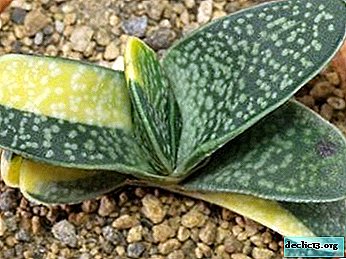 Moderate watering and a large amount of light are the key to the health of Gasteria. With a lack of sunshine, the leaves of Gasteria become thinner, elongate, lose their density and become brittle.
Moderate watering and a large amount of light are the key to the health of Gasteria. With a lack of sunshine, the leaves of Gasteria become thinner, elongate, lose their density and become brittle.- From overflow and stagnation of moisture, the plant can rot. At the first sign of rot, remove all affected parts with a capture of healthy tissue, dry and treat the plant with systemic fungicides.
- In conditions of constant dryness, a spider mite can start. Special drugs, acaricides, will help get rid of it. Of the improvised means, a warm shower is effective, but it must be combined with watering and the plant should be dried well after the procedure.
- Of the other pests, mention should be made of the mealybug and scale, which are disposed of with the help of insecticides. If necessary, the treatment is carried out several times. When working with chemicals, strictly follow the instructions and safety precautions.
- With a bacterial infection, the plant dies in a matter of days. The disease spreads very quickly. The dead plant should be thrown out with the earth, and the pot should be cleaned and treated with boiling water.
- In rare cases, the plant may be affected by the virus. It can be recognized by a change in the shape of the plant, the appearance of uncharacteristic spots and strokes, and the onset of symptoms on the entire plant. Such a plant is incurable and must be destroyed.
Conclusion
Gasteria is an unpretentious plant and is perfect for beginner growers. Due to the variety of colors and shapes, it is a promising plant for selection and can become the main star in any collection of cacti and succulents.

 Moderate watering and a large amount of light are the key to the health of Gasteria. With a lack of sunshine, the leaves of Gasteria become thinner, elongate, lose their density and become brittle.
Moderate watering and a large amount of light are the key to the health of Gasteria. With a lack of sunshine, the leaves of Gasteria become thinner, elongate, lose their density and become brittle.



